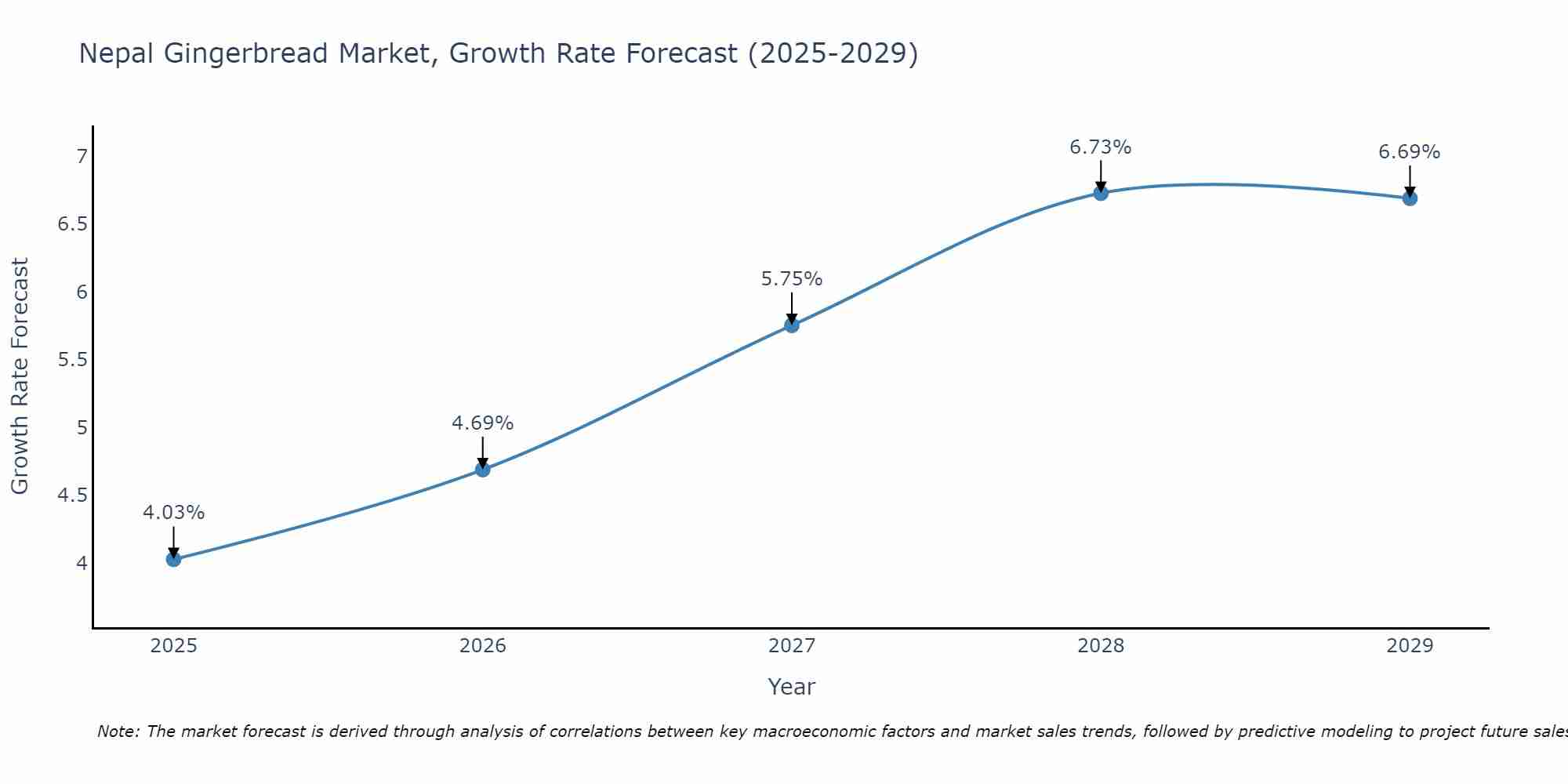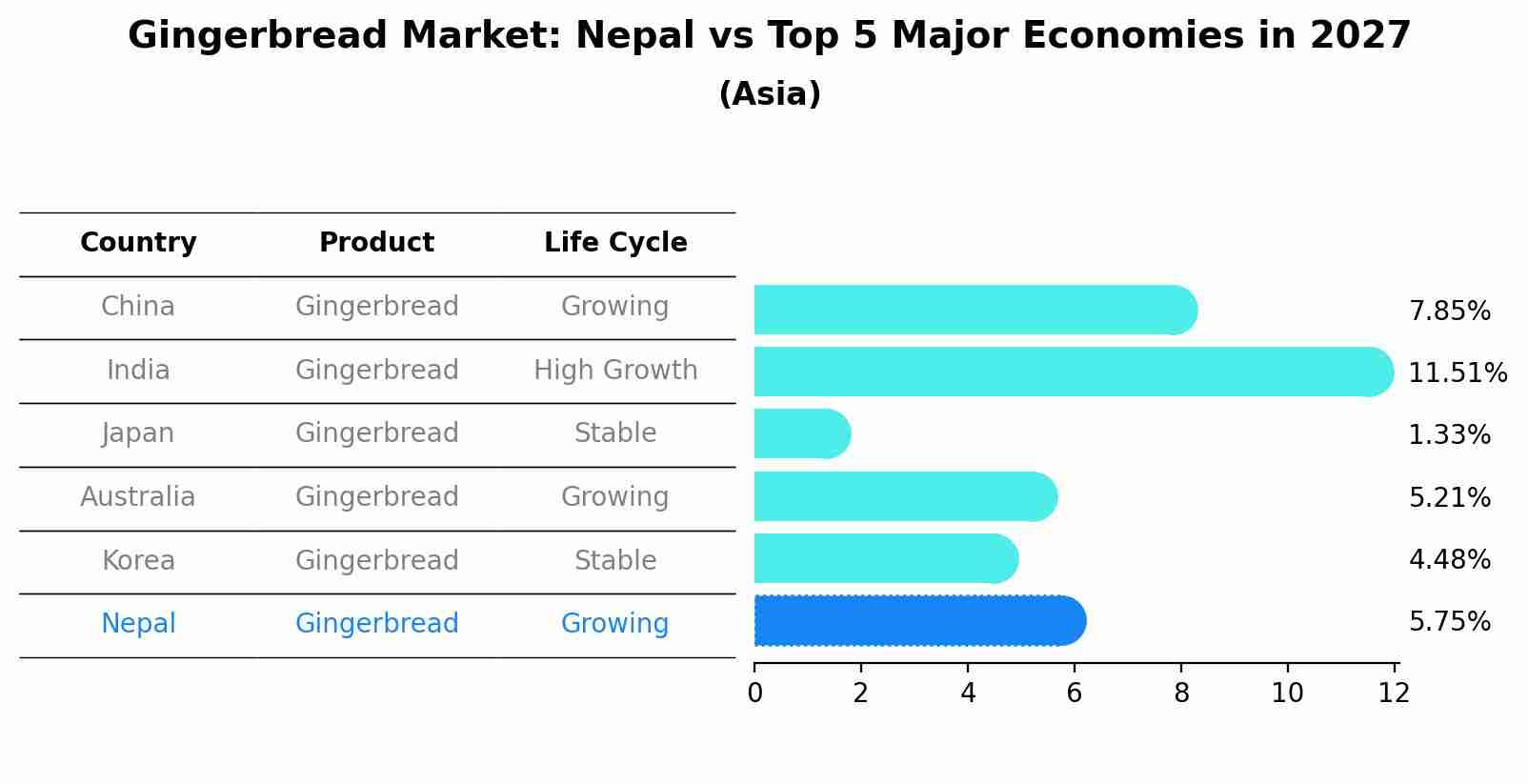Nepal Gingerbread Market (2025-2031) Outlook | Growth, Forecast, Size, Trends, Revenue, Share, Analysis, Industry, Companies, Value
| Product Code: ETC410852 | Publication Date: Oct 2022 | Updated Date: Jul 2025 | Product Type: Market Research Report | |
| Publisher: 6Wresearch | Author: Dhaval Chaurasia | No. of Pages: 75 | No. of Figures: 35 | No. of Tables: 20 |
Nepal Gingerbread Market Size Growth Rate
The Nepal Gingerbread Market is projected to witness mixed growth rate patterns during 2025 to 2029. Starting at 4.03% in 2025, the market peaks at 6.73% in 2028, and settles at 6.69% by 2029.

Gingerbread Market: Nepal vs Top 5 Major Economies in 2027 (Asia)
By 2027, the Gingerbread market in Nepal is anticipated to reach a growth rate of 5.75%, as part of an increasingly competitive Asia region, where China remains at the forefront, supported by India, Japan, Australia and South Korea, driving innovations and market adoption across sectors.

Nepal Gingerbread Market Synopsis
The Nepal gingerbread market is experiencing steady growth driven by the increasing popularity of gingerbread as a traditional snack and dessert option among the population. Gingerbread has a long-standing cultural significance in Nepal and is commonly consumed during festivals and special occasions. The market offers a variety of gingerbread products including cookies, cakes, and biscuits, with both homemade and commercially produced options available. Local bakeries and confectionery shops play a key role in distributing gingerbread products, catering to the demand from consumers looking for high-quality and authentic gingerbread treats. The market is also witnessing a trend towards innovative flavors and packaging to attract a wider consumer base, presenting opportunities for product diversification and expansion in the Nepal gingerbread market.
Nepal Gingerbread Market Trends
The Nepal gingerbread market is currently experiencing a trend towards premium and artisanal gingerbread products. Consumers are increasingly seeking high-quality gingerbread made from natural and locally sourced ingredients, reflecting a growing preference for healthier and more authentic options. Artisanal gingerbread makers are also incorporating innovative flavors and packaging to appeal to a more diverse consumer base. Additionally, there is a rising demand for gingerbread products that cater to specific dietary needs, such as gluten-free or vegan options. The market is also witnessing an increase in online sales and e-commerce platforms, providing consumers with convenient access to a wider variety of gingerbread products. Overall, the Nepal gingerbread market is evolving to meet the changing preferences and demands of consumers for premium, healthy, and diverse gingerbread offerings.
Nepal Gingerbread Market Challenges
In the Nepal gingerbread market, one of the primary challenges faced is the fluctuating supply of ginger due to weather conditions and crop failures. This can lead to inconsistent product quality and availability, impacting both producers and consumers. Additionally, limited access to modern processing and packaging technology hinders the market`s competitiveness and ability to meet quality standards for export markets. Lack of awareness about the health benefits and culinary versatility of gingerbread products among consumers also poses a challenge in expanding market reach and increasing demand. Overall, addressing these challenges through improved agricultural practices, technology adoption, and targeted marketing efforts can help strengthen the Nepal gingerbread market and enhance its growth potential.
Nepal Gingerbread Market Investment Opportunities
In the Nepal gingerbread market, there are several investment opportunities for potential investors. One option is to invest in gingerbread production facilities to cater to the growing demand for this traditional and popular treat. Another opportunity lies in exporting Nepali gingerbread products to international markets, leveraging the unique flavors and high quality of the local ingredients. Additionally, investing in technology and innovation to improve production processes and packaging can help companies gain a competitive edge in the market. Collaborating with local farmers to ensure a sustainable and consistent supply of ginger can also be a lucrative investment strategy. Overall, the Nepal gingerbread market offers various avenues for investment that can capitalize on the increasing popularity of this confectionery both domestically and internationally.
Jordan Agar Market Government Policies
The government of Nepal has implemented various policies to support and regulate the gingerbread market in the country. These policies include providing subsidies to gingerbread producers, ensuring quality standards are met through inspections and certifications, and promoting exports through trade agreements and incentives. Additionally, there are regulations in place to protect consumers by enforcing labeling requirements and monitoring food safety practices. The government also supports research and development in the gingerbread industry to enhance competitiveness and sustainability. Overall, these policies aim to stimulate growth in the gingerbread market, boost economic activity, and ensure the well-being of both producers and consumers in Nepal.
Nepal Gingerbread Market Future Outlook
The future outlook for the Nepal Gingerbread Market appears promising, driven by increasing consumer awareness of the health benefits associated with ginger as well as the growing popularity of organic and natural products. With a rising trend towards healthier snacking options and a preference for traditional and authentic flavors, gingerbread products are likely to gain traction among consumers in Nepal. Additionally, the tourism industry in Nepal presents an opportunity for the gingerbread market, as these products could be positioned as unique souvenirs or gifts for tourists visiting the country. The market is expected to witness steady growth, supported by product innovation, marketing efforts, and an expanding distribution network catering to both domestic and international markets.
Key Highlights of the Report:
- Nepal Gingerbread Market Outlook
- Market Size of Nepal Gingerbread Market, 2024
- Forecast of Nepal Gingerbread Market, 2031
- Historical Data and Forecast of Nepal Gingerbread Revenues & Volume for the Period 2021 - 2031
- Nepal Gingerbread Market Trend Evolution
- Nepal Gingerbread Market Drivers and Challenges
- Nepal Gingerbread Price Trends
- Nepal Gingerbread Porter's Five Forces
- Nepal Gingerbread Industry Life Cycle
- Historical Data and Forecast of Nepal Gingerbread Market Revenues & Volume By Application for the Period 2021 - 2031
- Historical Data and Forecast of Nepal Gingerbread Market Revenues & Volume By Household for the Period 2021 - 2031
- Historical Data and Forecast of Nepal Gingerbread Market Revenues & Volume By Commercial for the Period 2021 - 2031
- Historical Data and Forecast of Nepal Gingerbread Market Revenues & Volume By Distribution Channel for the Period 2021 - 2031
- Historical Data and Forecast of Nepal Gingerbread Market Revenues & Volume By Online for the Period 2021 - 2031
- Historical Data and Forecast of Nepal Gingerbread Market Revenues & Volume By Offline for the Period 2021 - 2031
- Nepal Gingerbread Import Export Trade Statistics
- Market Opportunity Assessment By Application
- Market Opportunity Assessment By Distribution Channel
- Nepal Gingerbread Top Companies Market Share
- Nepal Gingerbread Competitive Benchmarking By Technical and Operational Parameters
- Nepal Gingerbread Company Profiles
- Nepal Gingerbread Key Strategic Recommendations
Frequently Asked Questions About the Market Study (FAQs):
- Single User License$ 1,995
- Department License$ 2,400
- Site License$ 3,120
- Global License$ 3,795
Search
Thought Leadership and Analyst Meet
Our Clients
Related Reports
- Canada Oil and Gas Market (2026-2032) | Share, Segmentation, Value, Industry, Trends, Forecast, Analysis, Size & Revenue, Growth, Competitive Landscape, Outlook, Companies
- Germany Breakfast Food Market (2026-2032) | Industry, Share, Growth, Size, Companies, Value, Analysis, Revenue, Trends, Forecast & Outlook
- Australia Briquette Market (2025-2031) | Growth, Size, Revenue, Forecast, Analysis, Trends, Value, Share, Industry & Companies
- Vietnam System Integrator Market (2025-2031) | Size, Companies, Analysis, Industry, Value, Forecast, Growth, Trends, Revenue & Share
- ASEAN and Thailand Brain Health Supplements Market (2025-2031) | Strategy, Consumer Insights, Analysis, Investment Trends, Opportunities, Growth, Size, Share, Industry, Revenue, Segments, Value, Segmentation, Supply, Forecast, Restraints, Outlook, Competition, Drivers, Trends, Demand, Pricing Analysis, Competitive, Strategic Insights, Companies, Challenges
- ASEAN Bearings Market (2025-2031) | Strategy, Consumer Insights, Analysis, Investment Trends, Opportunities, Growth, Size, Share, Industry, Revenue, Segments, Value, Segmentation, Supply, Forecast, Restraints, Outlook, Competition, Drivers, Trends, Demand, Pricing Analysis, Competitive, Strategic Insights, Companies, Challenges
- Europe Flooring Market (2025-2031) | Outlook, Share, Industry, Trends, Forecast, Companies, Revenue, Size, Analysis, Growth & Value
- Saudi Arabia Manlift Market (2025-2031) | Outlook, Size, Growth, Trends, Companies, Industry, Revenue, Value, Share, Forecast & Analysis
- Uganda Excavator, Crane, and Wheel Loaders Market (2025-2031) | Strategy, Consumer Insights, Analysis, Investment Trends, Opportunities, Growth, Size, Share, Industry, Revenue, Segments, Value, Segmentation, Supply, Forecast, Restraints, Outlook, Competition, Drivers, Trends, Demand, Pricing Analysis, Competitive, Strategic Insights, Companies, Challenges
- Rwanda Excavator, Crane, and Wheel Loaders Market (2025-2031) | Strategy, Consumer Insights, Analysis, Investment Trends, Opportunities, Growth, Size, Share, Industry, Revenue, Segments, Value, Segmentation, Supply, Forecast, Restraints, Outlook, Competition, Drivers, Trends, Demand, Pricing Analysis, Competitive, Strategic Insights, Companies, Challenges
Industry Events and Analyst Meet
Whitepaper
- Middle East & Africa Commercial Security Market Click here to view more.
- Middle East & Africa Fire Safety Systems & Equipment Market Click here to view more.
- GCC Drone Market Click here to view more.
- Middle East Lighting Fixture Market Click here to view more.
- GCC Physical & Perimeter Security Market Click here to view more.
6WResearch In News
- Doha a strategic location for EV manufacturing hub: IPA Qatar
- Demand for luxury TVs surging in the GCC, says Samsung
- Empowering Growth: The Thriving Journey of Bangladesh’s Cable Industry
- Demand for luxury TVs surging in the GCC, says Samsung
- Video call with a traditional healer? Once unthinkable, it’s now common in South Africa
- Intelligent Buildings To Smooth GCC’s Path To Net Zero


















